ITECH1102: Networking and Security Report - Data Link, Transport Layer
VerifiedAdded on 2023/04/25
|5
|1493
|336
Report
AI Summary
This report delves into key aspects of networking and security, covering the data link layer, transport layer, cloud computing, and mobile computing. The data link layer's role in local network communication, including its logical link and media access control components, is examined, along with the function of network interface cards (NICs) and MAC addresses. The transport layer, focusing on TCP, is explored, highlighting its role in reliable data delivery, connection establishment, and flow control. The report also touches upon cloud computing, including its advantages and disadvantages, and examines the evolution of mobile computing networks, from 1G to 4G, including the switching technologies and carrier frequencies used in each generation.
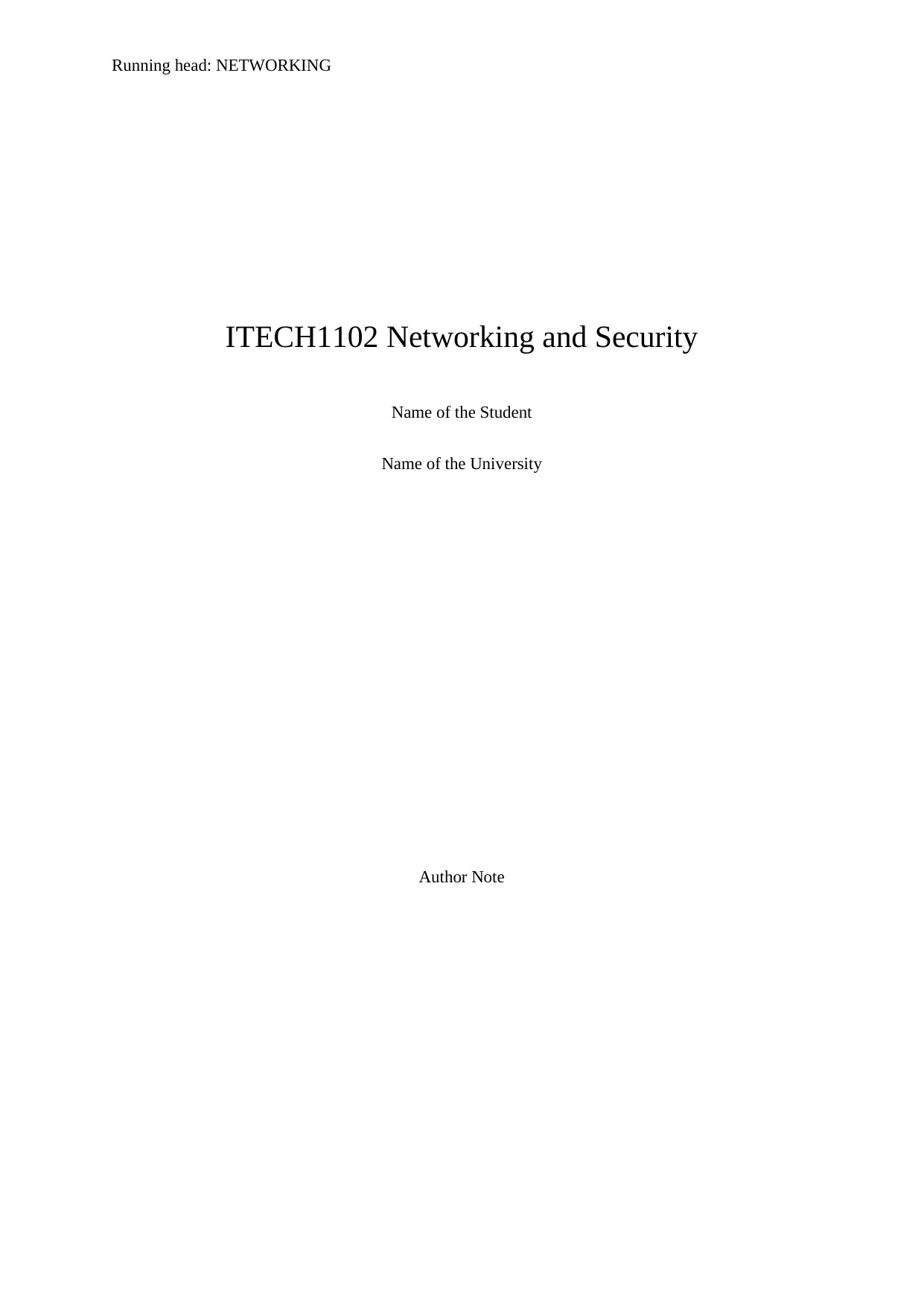
Running head: NETWORKING
ITECH1102 Networking and Security
Name of the Student
Name of the University
Author Note
ITECH1102 Networking and Security
Name of the Student
Name of the University
Author Note
Paraphrase This Document
Need a fresh take? Get an instant paraphrase of this document with our AI Paraphraser
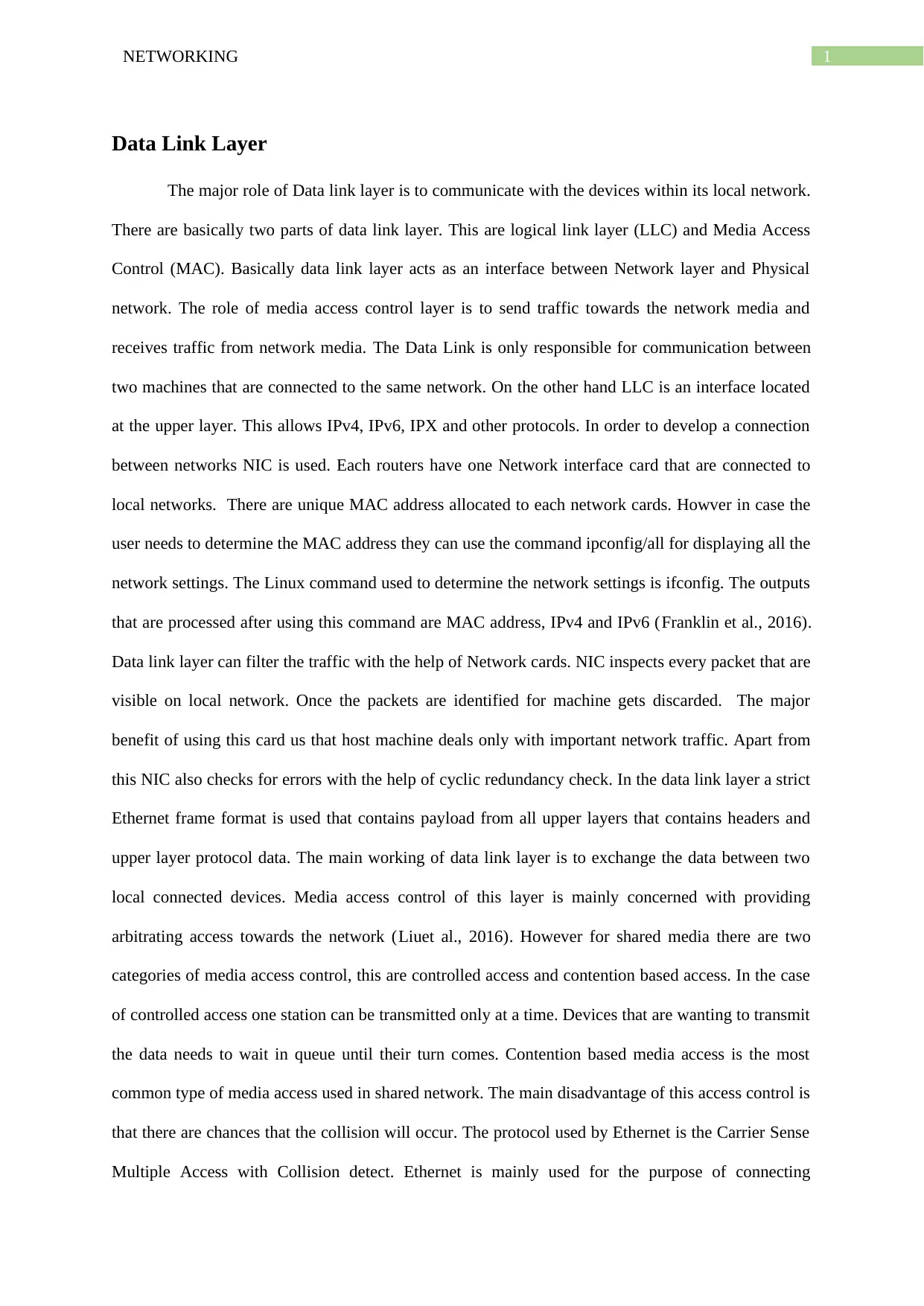
1NETWORKING
Data Link Layer
The major role of Data link layer is to communicate with the devices within its local network.
There are basically two parts of data link layer. This are logical link layer (LLC) and Media Access
Control (MAC). Basically data link layer acts as an interface between Network layer and Physical
network. The role of media access control layer is to send traffic towards the network media and
receives traffic from network media. The Data Link is only responsible for communication between
two machines that are connected to the same network. On the other hand LLC is an interface located
at the upper layer. This allows IPv4, IPv6, IPX and other protocols. In order to develop a connection
between networks NIC is used. Each routers have one Network interface card that are connected to
local networks. There are unique MAC address allocated to each network cards. Howver in case the
user needs to determine the MAC address they can use the command ipconfig/all for displaying all the
network settings. The Linux command used to determine the network settings is ifconfig. The outputs
that are processed after using this command are MAC address, IPv4 and IPv6 (Franklin et al., 2016).
Data link layer can filter the traffic with the help of Network cards. NIC inspects every packet that are
visible on local network. Once the packets are identified for machine gets discarded. The major
benefit of using this card us that host machine deals only with important network traffic. Apart from
this NIC also checks for errors with the help of cyclic redundancy check. In the data link layer a strict
Ethernet frame format is used that contains payload from all upper layers that contains headers and
upper layer protocol data. The main working of data link layer is to exchange the data between two
local connected devices. Media access control of this layer is mainly concerned with providing
arbitrating access towards the network (Liuet al., 2016). However for shared media there are two
categories of media access control, this are controlled access and contention based access. In the case
of controlled access one station can be transmitted only at a time. Devices that are wanting to transmit
the data needs to wait in queue until their turn comes. Contention based media access is the most
common type of media access used in shared network. The main disadvantage of this access control is
that there are chances that the collision will occur. The protocol used by Ethernet is the Carrier Sense
Multiple Access with Collision detect. Ethernet is mainly used for the purpose of connecting
Data Link Layer
The major role of Data link layer is to communicate with the devices within its local network.
There are basically two parts of data link layer. This are logical link layer (LLC) and Media Access
Control (MAC). Basically data link layer acts as an interface between Network layer and Physical
network. The role of media access control layer is to send traffic towards the network media and
receives traffic from network media. The Data Link is only responsible for communication between
two machines that are connected to the same network. On the other hand LLC is an interface located
at the upper layer. This allows IPv4, IPv6, IPX and other protocols. In order to develop a connection
between networks NIC is used. Each routers have one Network interface card that are connected to
local networks. There are unique MAC address allocated to each network cards. Howver in case the
user needs to determine the MAC address they can use the command ipconfig/all for displaying all the
network settings. The Linux command used to determine the network settings is ifconfig. The outputs
that are processed after using this command are MAC address, IPv4 and IPv6 (Franklin et al., 2016).
Data link layer can filter the traffic with the help of Network cards. NIC inspects every packet that are
visible on local network. Once the packets are identified for machine gets discarded. The major
benefit of using this card us that host machine deals only with important network traffic. Apart from
this NIC also checks for errors with the help of cyclic redundancy check. In the data link layer a strict
Ethernet frame format is used that contains payload from all upper layers that contains headers and
upper layer protocol data. The main working of data link layer is to exchange the data between two
local connected devices. Media access control of this layer is mainly concerned with providing
arbitrating access towards the network (Liuet al., 2016). However for shared media there are two
categories of media access control, this are controlled access and contention based access. In the case
of controlled access one station can be transmitted only at a time. Devices that are wanting to transmit
the data needs to wait in queue until their turn comes. Contention based media access is the most
common type of media access used in shared network. The main disadvantage of this access control is
that there are chances that the collision will occur. The protocol used by Ethernet is the Carrier Sense
Multiple Access with Collision detect. Ethernet is mainly used for the purpose of connecting
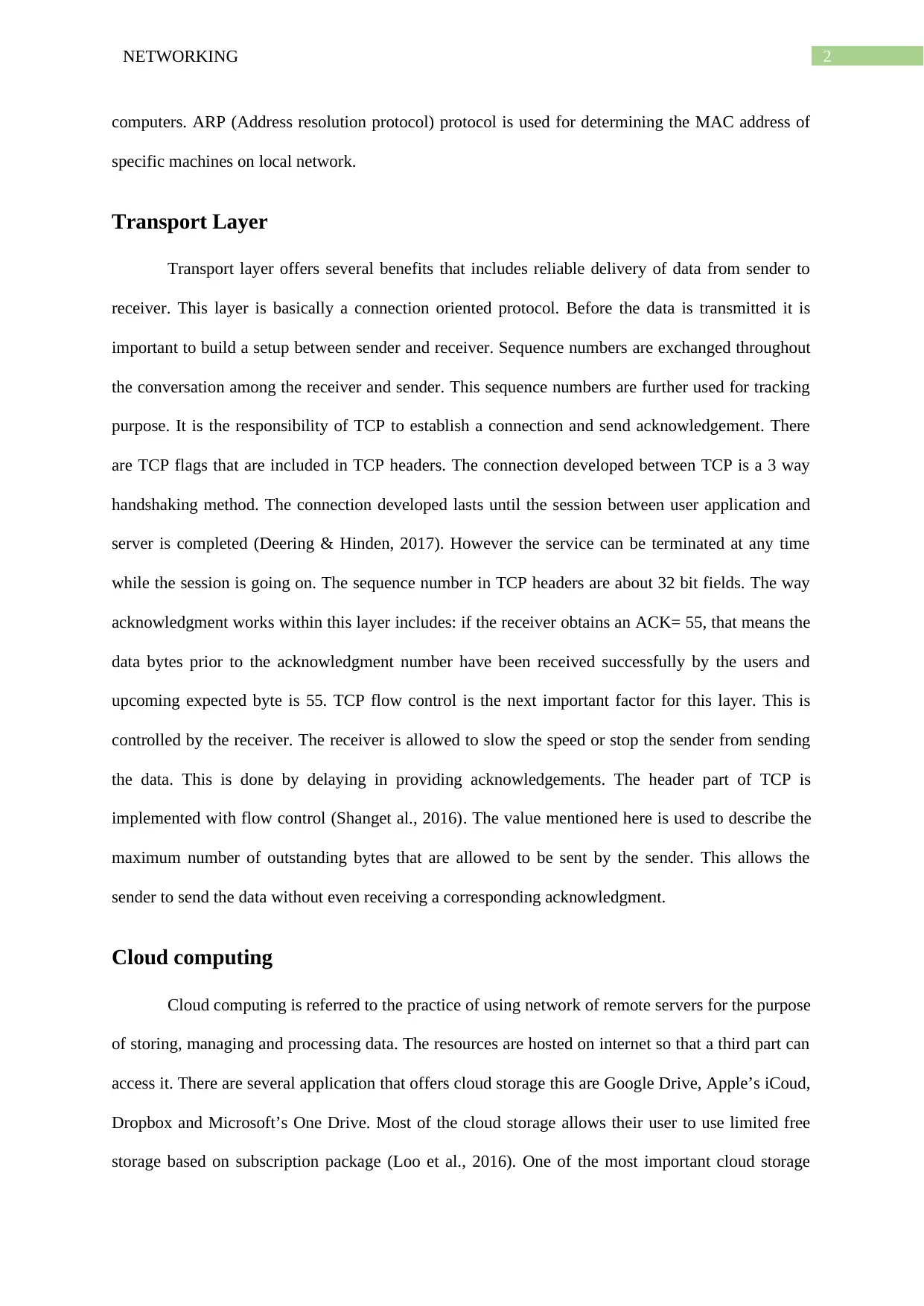
2NETWORKING
computers. ARP (Address resolution protocol) protocol is used for determining the MAC address of
specific machines on local network.
Transport Layer
Transport layer offers several benefits that includes reliable delivery of data from sender to
receiver. This layer is basically a connection oriented protocol. Before the data is transmitted it is
important to build a setup between sender and receiver. Sequence numbers are exchanged throughout
the conversation among the receiver and sender. This sequence numbers are further used for tracking
purpose. It is the responsibility of TCP to establish a connection and send acknowledgement. There
are TCP flags that are included in TCP headers. The connection developed between TCP is a 3 way
handshaking method. The connection developed lasts until the session between user application and
server is completed (Deering & Hinden, 2017). However the service can be terminated at any time
while the session is going on. The sequence number in TCP headers are about 32 bit fields. The way
acknowledgment works within this layer includes: if the receiver obtains an ACK= 55, that means the
data bytes prior to the acknowledgment number have been received successfully by the users and
upcoming expected byte is 55. TCP flow control is the next important factor for this layer. This is
controlled by the receiver. The receiver is allowed to slow the speed or stop the sender from sending
the data. This is done by delaying in providing acknowledgements. The header part of TCP is
implemented with flow control (Shanget al., 2016). The value mentioned here is used to describe the
maximum number of outstanding bytes that are allowed to be sent by the sender. This allows the
sender to send the data without even receiving a corresponding acknowledgment.
Cloud computing
Cloud computing is referred to the practice of using network of remote servers for the purpose
of storing, managing and processing data. The resources are hosted on internet so that a third part can
access it. There are several application that offers cloud storage this are Google Drive, Apple’s iCoud,
Dropbox and Microsoft’s One Drive. Most of the cloud storage allows their user to use limited free
storage based on subscription package (Loo et al., 2016). One of the most important cloud storage
computers. ARP (Address resolution protocol) protocol is used for determining the MAC address of
specific machines on local network.
Transport Layer
Transport layer offers several benefits that includes reliable delivery of data from sender to
receiver. This layer is basically a connection oriented protocol. Before the data is transmitted it is
important to build a setup between sender and receiver. Sequence numbers are exchanged throughout
the conversation among the receiver and sender. This sequence numbers are further used for tracking
purpose. It is the responsibility of TCP to establish a connection and send acknowledgement. There
are TCP flags that are included in TCP headers. The connection developed between TCP is a 3 way
handshaking method. The connection developed lasts until the session between user application and
server is completed (Deering & Hinden, 2017). However the service can be terminated at any time
while the session is going on. The sequence number in TCP headers are about 32 bit fields. The way
acknowledgment works within this layer includes: if the receiver obtains an ACK= 55, that means the
data bytes prior to the acknowledgment number have been received successfully by the users and
upcoming expected byte is 55. TCP flow control is the next important factor for this layer. This is
controlled by the receiver. The receiver is allowed to slow the speed or stop the sender from sending
the data. This is done by delaying in providing acknowledgements. The header part of TCP is
implemented with flow control (Shanget al., 2016). The value mentioned here is used to describe the
maximum number of outstanding bytes that are allowed to be sent by the sender. This allows the
sender to send the data without even receiving a corresponding acknowledgment.
Cloud computing
Cloud computing is referred to the practice of using network of remote servers for the purpose
of storing, managing and processing data. The resources are hosted on internet so that a third part can
access it. There are several application that offers cloud storage this are Google Drive, Apple’s iCoud,
Dropbox and Microsoft’s One Drive. Most of the cloud storage allows their user to use limited free
storage based on subscription package (Loo et al., 2016). One of the most important cloud storage
⊘ This is a preview!⊘
Do you want full access?
Subscribe today to unlock all pages.

Trusted by 1+ million students worldwide
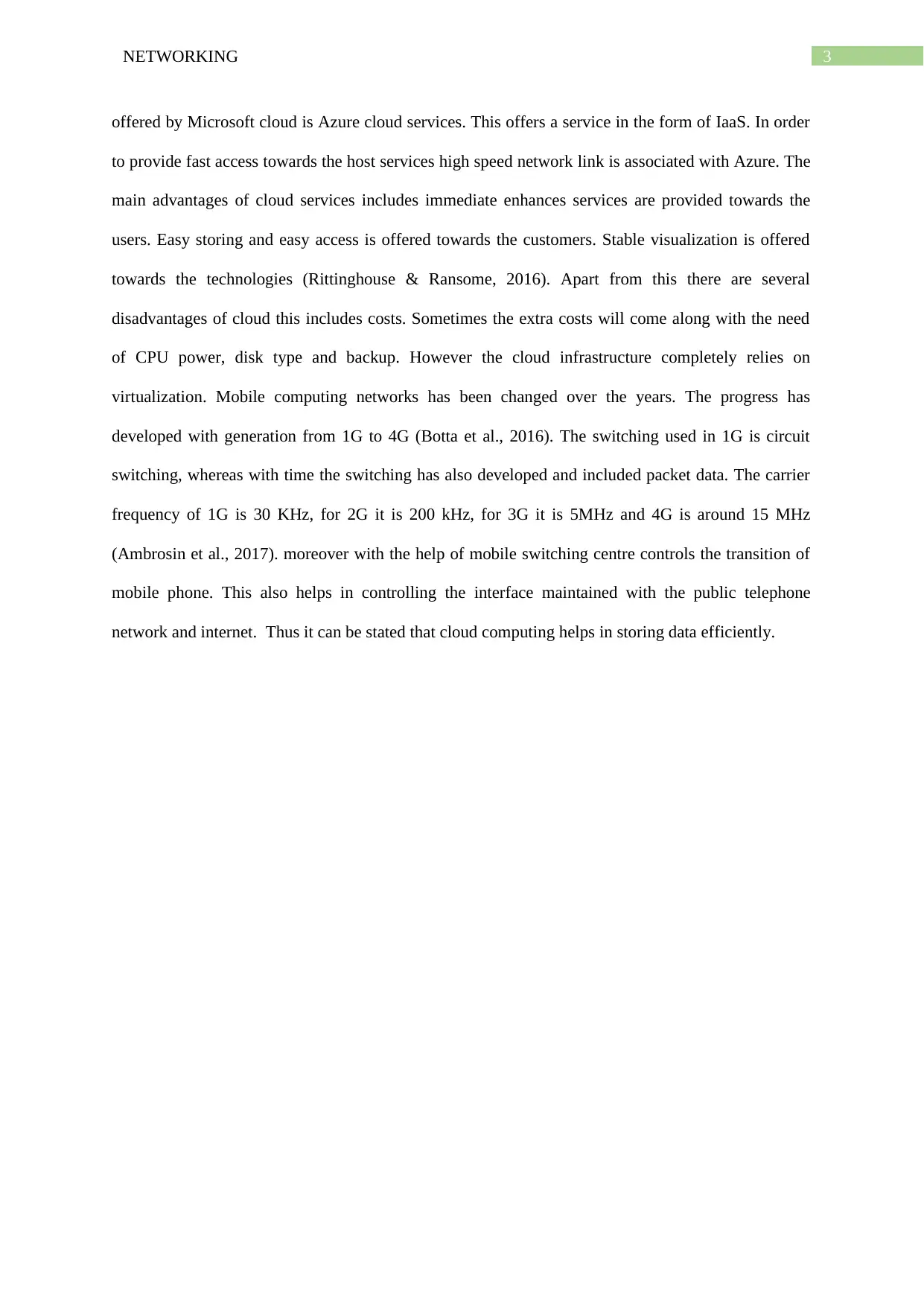
3NETWORKING
offered by Microsoft cloud is Azure cloud services. This offers a service in the form of IaaS. In order
to provide fast access towards the host services high speed network link is associated with Azure. The
main advantages of cloud services includes immediate enhances services are provided towards the
users. Easy storing and easy access is offered towards the customers. Stable visualization is offered
towards the technologies (Rittinghouse & Ransome, 2016). Apart from this there are several
disadvantages of cloud this includes costs. Sometimes the extra costs will come along with the need
of CPU power, disk type and backup. However the cloud infrastructure completely relies on
virtualization. Mobile computing networks has been changed over the years. The progress has
developed with generation from 1G to 4G (Botta et al., 2016). The switching used in 1G is circuit
switching, whereas with time the switching has also developed and included packet data. The carrier
frequency of 1G is 30 KHz, for 2G it is 200 kHz, for 3G it is 5MHz and 4G is around 15 MHz
(Ambrosin et al., 2017). moreover with the help of mobile switching centre controls the transition of
mobile phone. This also helps in controlling the interface maintained with the public telephone
network and internet. Thus it can be stated that cloud computing helps in storing data efficiently.
offered by Microsoft cloud is Azure cloud services. This offers a service in the form of IaaS. In order
to provide fast access towards the host services high speed network link is associated with Azure. The
main advantages of cloud services includes immediate enhances services are provided towards the
users. Easy storing and easy access is offered towards the customers. Stable visualization is offered
towards the technologies (Rittinghouse & Ransome, 2016). Apart from this there are several
disadvantages of cloud this includes costs. Sometimes the extra costs will come along with the need
of CPU power, disk type and backup. However the cloud infrastructure completely relies on
virtualization. Mobile computing networks has been changed over the years. The progress has
developed with generation from 1G to 4G (Botta et al., 2016). The switching used in 1G is circuit
switching, whereas with time the switching has also developed and included packet data. The carrier
frequency of 1G is 30 KHz, for 2G it is 200 kHz, for 3G it is 5MHz and 4G is around 15 MHz
(Ambrosin et al., 2017). moreover with the help of mobile switching centre controls the transition of
mobile phone. This also helps in controlling the interface maintained with the public telephone
network and internet. Thus it can be stated that cloud computing helps in storing data efficiently.
Paraphrase This Document
Need a fresh take? Get an instant paraphrase of this document with our AI Paraphraser
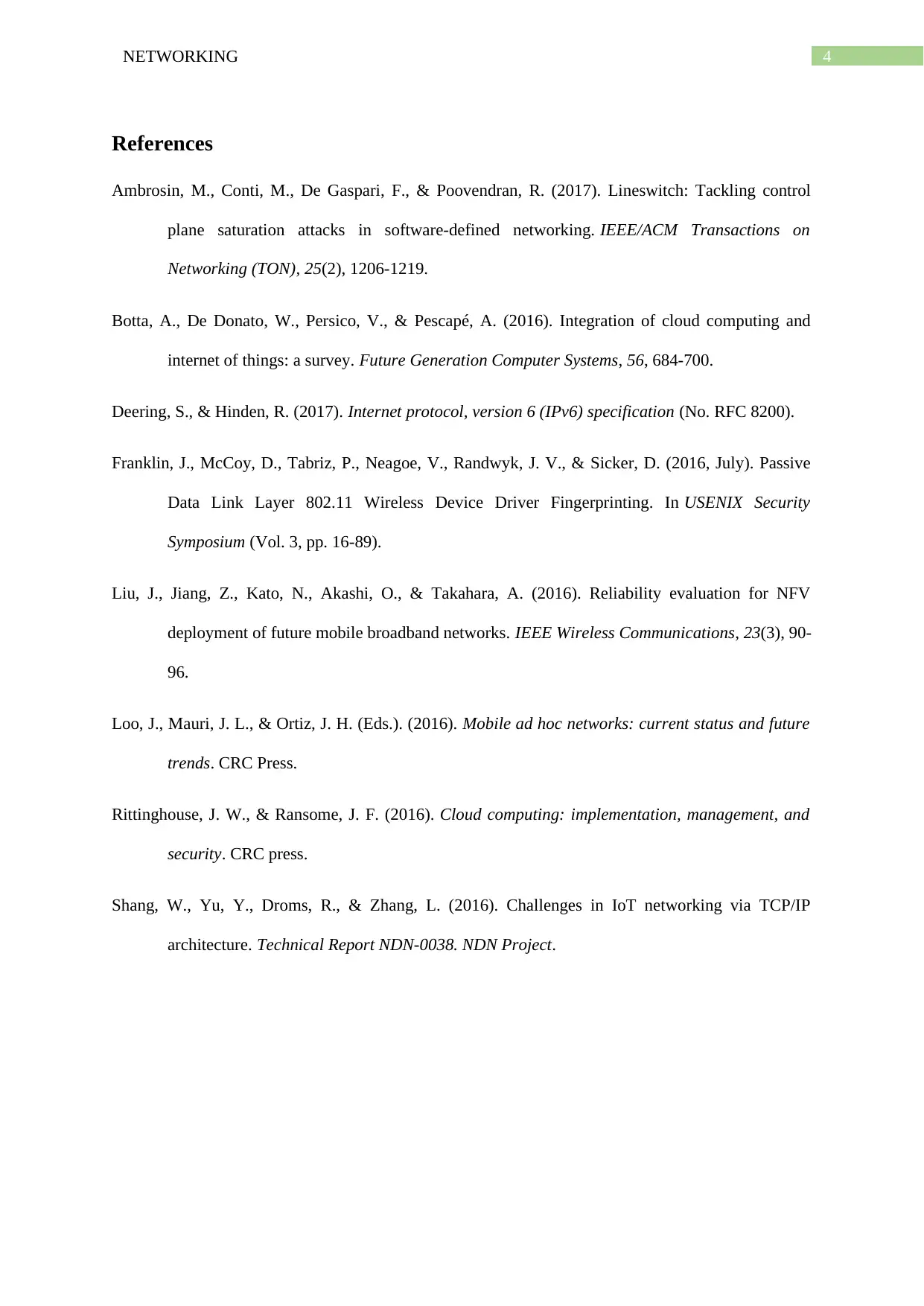
4NETWORKING
References
Ambrosin, M., Conti, M., De Gaspari, F., & Poovendran, R. (2017). Lineswitch: Tackling control
plane saturation attacks in software-defined networking. IEEE/ACM Transactions on
Networking (TON), 25(2), 1206-1219.
Botta, A., De Donato, W., Persico, V., & Pescapé, A. (2016). Integration of cloud computing and
internet of things: a survey. Future Generation Computer Systems, 56, 684-700.
Deering, S., & Hinden, R. (2017). Internet protocol, version 6 (IPv6) specification (No. RFC 8200).
Franklin, J., McCoy, D., Tabriz, P., Neagoe, V., Randwyk, J. V., & Sicker, D. (2016, July). Passive
Data Link Layer 802.11 Wireless Device Driver Fingerprinting. In USENIX Security
Symposium (Vol. 3, pp. 16-89).
Liu, J., Jiang, Z., Kato, N., Akashi, O., & Takahara, A. (2016). Reliability evaluation for NFV
deployment of future mobile broadband networks. IEEE Wireless Communications, 23(3), 90-
96.
Loo, J., Mauri, J. L., & Ortiz, J. H. (Eds.). (2016). Mobile ad hoc networks: current status and future
trends. CRC Press.
Rittinghouse, J. W., & Ransome, J. F. (2016). Cloud computing: implementation, management, and
security. CRC press.
Shang, W., Yu, Y., Droms, R., & Zhang, L. (2016). Challenges in IoT networking via TCP/IP
architecture. Technical Report NDN-0038. NDN Project.
References
Ambrosin, M., Conti, M., De Gaspari, F., & Poovendran, R. (2017). Lineswitch: Tackling control
plane saturation attacks in software-defined networking. IEEE/ACM Transactions on
Networking (TON), 25(2), 1206-1219.
Botta, A., De Donato, W., Persico, V., & Pescapé, A. (2016). Integration of cloud computing and
internet of things: a survey. Future Generation Computer Systems, 56, 684-700.
Deering, S., & Hinden, R. (2017). Internet protocol, version 6 (IPv6) specification (No. RFC 8200).
Franklin, J., McCoy, D., Tabriz, P., Neagoe, V., Randwyk, J. V., & Sicker, D. (2016, July). Passive
Data Link Layer 802.11 Wireless Device Driver Fingerprinting. In USENIX Security
Symposium (Vol. 3, pp. 16-89).
Liu, J., Jiang, Z., Kato, N., Akashi, O., & Takahara, A. (2016). Reliability evaluation for NFV
deployment of future mobile broadband networks. IEEE Wireless Communications, 23(3), 90-
96.
Loo, J., Mauri, J. L., & Ortiz, J. H. (Eds.). (2016). Mobile ad hoc networks: current status and future
trends. CRC Press.
Rittinghouse, J. W., & Ransome, J. F. (2016). Cloud computing: implementation, management, and
security. CRC press.
Shang, W., Yu, Y., Droms, R., & Zhang, L. (2016). Challenges in IoT networking via TCP/IP
architecture. Technical Report NDN-0038. NDN Project.
1 out of 5
Related Documents
Your All-in-One AI-Powered Toolkit for Academic Success.
+13062052269
info@desklib.com
Available 24*7 on WhatsApp / Email
![[object Object]](/_next/static/media/star-bottom.7253800d.svg)
Unlock your academic potential
Copyright © 2020–2025 A2Z Services. All Rights Reserved. Developed and managed by ZUCOL.





